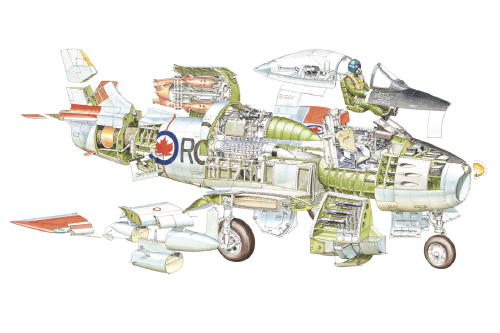Secret Weapons Projects (June 1944 - May 1945)
Secret Weapons Projects (June 1944 - May 1945)
 Hitler tried to sustain morale by promising that "secret weapons" would turn the war around. He did indeed have the weapons. The first of 9,300 V-1 flying bombs hit London in mid- June, 1944, and together with 1,300 V-2 rockets caused 8,000 civilian deaths and 23,000 injuries. Although they did not seriously undercut British morale or munitions production, they bothered the British government a great deal - Germany now had its own unanswered weapons system. Using proximity fuzes, British anti-aircraft artillery gunners (many of them women) learned how to shoot down the 400 mph V-1s; nothing could stop the supersonic V-2s. The British government, in near panic, demanded that upwards of 40% of bomber sorties be targeted against the launch sites, and got its way in "Operation CROSSBOW." The attacks were futile, and the diversion represented a major success for Hitler. In early 1943 the strategic bombers were directed against U- boat pens, which were easy to reach and which represented a major strategic threat to Allied logistics. However, the pens were very solidly built - it took 7,000 flying hours to destroy one sub there, about the same effort that it took to destroy one-third of Cologne. The antisubmarine campaign thus was a victory for Hitler.
Hitler tried to sustain morale by promising that "secret weapons" would turn the war around. He did indeed have the weapons. The first of 9,300 V-1 flying bombs hit London in mid- June, 1944, and together with 1,300 V-2 rockets caused 8,000 civilian deaths and 23,000 injuries. Although they did not seriously undercut British morale or munitions production, they bothered the British government a great deal - Germany now had its own unanswered weapons system. Using proximity fuzes, British anti-aircraft artillery gunners (many of them women) learned how to shoot down the 400 mph V-1s; nothing could stop the supersonic V-2s. The British government, in near panic, demanded that upwards of 40% of bomber sorties be targeted against the launch sites, and got its way in "Operation CROSSBOW." The attacks were futile, and the diversion represented a major success for Hitler. In early 1943 the strategic bombers were directed against U- boat pens, which were easy to reach and which represented a major strategic threat to Allied logistics. However, the pens were very solidly built - it took 7,000 flying hours to destroy one sub there, about the same effort that it took to destroy one-third of Cologne. The antisubmarine campaign thus was a victory for Hitler.
Every raid against a V-1 or V-2 launch site was one less raid against the Third Reich. On the whole, however, the secret weapons were still another case of too little too late. The Luftwaffe ran the V-1 program, which used a jet engine, but it diverted scarce engineering talent and manufacturing capacity that were urgently needed to improve German radar, air defense, and jet fighters. The German Army ran the V-2 program. The rockets were a technological triumph, and bothered the British leadership even more than the V-1s. But they were so inaccurate they rarely could hit militarily significant targets.
|
|
|





 Hitler tried to sustain morale by promising that "secret weapons" would turn the war around. He did indeed have the weapons. The first of 9,300 V-1 flying bombs hit London in mid- June, 1944, and together with 1,300 V-2 rockets caused 8,000 civilian deaths and 23,000 injuries. Although they did not seriously undercut British morale or munitions production, they bothered the British government a great deal - Germany now had its own unanswered weapons system. Using proximity fuzes, British anti-aircraft artillery gunners (many of them women) learned how to shoot down the 400 mph V-1s; nothing could stop the supersonic V-2s. The British government, in near panic, demanded that upwards of 40% of bomber sorties be targeted against the launch sites, and got its way in "Operation CROSSBOW." The attacks were futile, and the diversion represented a major success for Hitler. In early 1943 the strategic bombers were directed against U- boat pens, which were easy to reach and which represented a major strategic threat to Allied logistics. However, the pens were very solidly built - it took 7,000 flying hours to destroy one sub there, about the same effort that it took to destroy one-third of Cologne. The antisubmarine campaign thus was a victory for Hitler.
Hitler tried to sustain morale by promising that "secret weapons" would turn the war around. He did indeed have the weapons. The first of 9,300 V-1 flying bombs hit London in mid- June, 1944, and together with 1,300 V-2 rockets caused 8,000 civilian deaths and 23,000 injuries. Although they did not seriously undercut British morale or munitions production, they bothered the British government a great deal - Germany now had its own unanswered weapons system. Using proximity fuzes, British anti-aircraft artillery gunners (many of them women) learned how to shoot down the 400 mph V-1s; nothing could stop the supersonic V-2s. The British government, in near panic, demanded that upwards of 40% of bomber sorties be targeted against the launch sites, and got its way in "Operation CROSSBOW." The attacks were futile, and the diversion represented a major success for Hitler. In early 1943 the strategic bombers were directed against U- boat pens, which were easy to reach and which represented a major strategic threat to Allied logistics. However, the pens were very solidly built - it took 7,000 flying hours to destroy one sub there, about the same effort that it took to destroy one-third of Cologne. The antisubmarine campaign thus was a victory for Hitler.